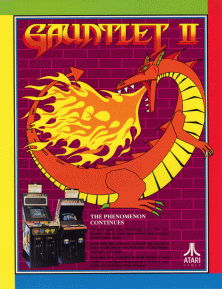Gauntlet II
| Gauntlet II | |
|---|---|
 Arcade game flyer | |
| Developer(s) | Atari Games |
| Publisher(s) | Atari Games |
| Designer(s) | Ed Logg |
| Series | Gauntlet |
| Platform(s) |
Arcade (original) Amiga, Amstrad CPC, Atari ST, Commodore 64, Game Boy, MS-DOS, NES, ZX Spectrum |
| Release | 1986[1] |
| Genre(s) | Hack and slash, dungeon crawl |
| Mode(s) | Up to 4 players simultaneously |
| Cabinet | Upright |
| Arcade system | Atari Gauntlet |
| CPU | 1×Motorola 68010 @ 7.15909 MHz, 1x MOS Technology 6502 @ 1.789772 MHz[2] |
| Sound | 1×Yamaha YM2151 @ 3.579545, 1x Atari POKEY @ 1.789772 MHz, 1×Texas Instruments TMS5220@ 650.826 kHz |
| Display | Raster, standard resolution, 19 inch, horizontal |
Gauntlet II is a 1986 arcade game released by Atari Games and the first sequel to 1985's Gauntlet. Gauntlet II, like its predecessor, is a fantasy-themed hack and slash game.
Gameplay
The gameplay is very similar to the original Gauntlet, a top down dungeon crawl supporting up to four players. The biggest difference from the original game is that players can choose identical classes, instead of being limited to a particular one for each joystick; each player is differentiated by color. Thus, instead of having a "warrior", "wizard", and "valkyrie" (for instance), in Gauntlet II there could be a "red wizard", a "blue elf" and a "green warrior".
In addition to the new "class" system, new level designs were added, including the possibility of encountering them in altered ways by having the play-field turned in steps of 90°. Other new features included the enemy "It", which upon contact would make a player "It" and draw all enemies towards him/her. The only way to release this curse is by touching another player or entering the exit, turning any level containing "It" into a fantasy filled game of tag. Other notable additions include the ability to ricochet shots off walls by means of a special pick-up, acid puddles that caused large, predetermined amounts of damage and a large dragon which would occupy multiple squares and require multiple hits to destroy.[2]
New level elements were also added, adding more variety to the original game. These included "all walls are invisible", "magic walls" which changed into monsters or items when hit, "stun tiles" which stunned the player, and fake exits.
Another challenge in the game is the possibility to find a "secret room". This can be found by completing specific achievements within the level (e.g., "don't be fooled", means that you must find the real exit first). The secret room contains items such as food and magic potions (extra shot power, extra shot speed, extra magic power, extra speed, extra armor and extra fight power).
Ports and re-releases
Home versions of Gauntlet II were released in the United States by Mindscape and Europe by U.S. Gold. Among the console versions of the game, a 1992 Game Boy version was released, and on May 3, 2007, a PlayStation 3 port became available for download,[3] but that version has since been removed from the PS3's online store. The port for the Nintendo Entertainment System was among the first NES games to support 4-player mode.
Gauntlet II was part of the 2012 compilation Midway Arcade Origins.[4]
Reception
| Reception | ||||||||||||||||||||||||||||||||
|---|---|---|---|---|---|---|---|---|---|---|---|---|---|---|---|---|---|---|---|---|---|---|---|---|---|---|---|---|---|---|---|---|
| ||||||||||||||||||||||||||||||||
| ||||||||||||||||||||||||||||||||
The Game Boy version was praised by the German Play Time magazine for its technical implementation (including 8-directional scrolling), faithful recreation of graphics, and for evoking nostalgic feelings with similar sound effects, however this version was criticized for difficult-to-recognize sprites and its technically weak theme music.[17]
The Spectrum version of the game was not received as well as the original, however Sinclair User said it was "A corker. Fast action and superb gameplay make Gauntlet II probably the first sequel worth the cash". Your Sinclair said it was "A 'must have' for all of you who asked for Gauntlet on your Desert Island Disks." Both YS and Crash gave the main weaknesses as the sound and the over-similarity to the original.
References
- ↑ "Gauntlet II". The International Arcade Museum.
- 1 2 "Gauntlet II The Arcade Video Game by Atari Games Corp". Arcade History.
- ↑ "Gauntlet 2". GameSpot.com. Archived from the original on September 23, 2011. Retrieved 2013-06-15.
- ↑ "Squeezing 30 fridge-sized games onto a disc proves difficult". ign.com. November 13, 2012.
- ↑ "Gauntlet II Review". C+VG. EMAP (81): 34–35. July 1988.
- ↑ "Gauntlet II Review". Crash!. Newsfield Publications Ltd (49): 94. February 1988.
- ↑ "Gauntlet II Review". Sinclair User. EMAP (70): 29. January 1988.
- ↑ "Gauntlet II Review". Your Sinclair. Future plc (26): 65. February 1988.
- ↑ "Gauntlet II Review". ACE. EMAP (12): 63. October 1988.
- ↑ "Updates: Amiga - Gauntlet II". ACE. EMAP (20): 77. May 1989.
- ↑ "Gauntlet II Review". Amiga Action. Europress: 92. Apr 1991.
- ↑ "Gauntlet II Review". Atari ST User. 3 (7): 35. September 1988.
- ↑ "Gauntlet II Review". Amiga User International. 3 (2): 28. February 1989.
- ↑ "Gauntlet II Review". Commodore User (53): 17. February 1988.
- ↑ "Gauntlet II Review". Commodore User (65): 20. February 1989.
- ↑ "A Fist Off Iron Too". The Games Machine. Newsfield (11): 68–69. July 1988.
- 1 2 Hans, Ipisch (June 1992). "Gauntlet II". Play Time: 82.
- ↑ "Gauntlet II Review". ST Action. 1 (4): 60–62. August 1988.
- ↑ "Gauntlet II Review". Your Amiga: 32. June 1989.
- ↑ "Gauntlet II Review". Zzap!64. Newsfield (35): 11. March 1988.
External links
| Wikiquote has quotations related to: Gauntlet II |
- Gauntlet II at the Killer List of Videogames
- Gauntlet II at the Arcade History database
- Gauntlet II for the Atari ST at Atari Mania
- Gauntlet II at Lemon 64
- Gauntlet II at SpectrumComputing.co.uk